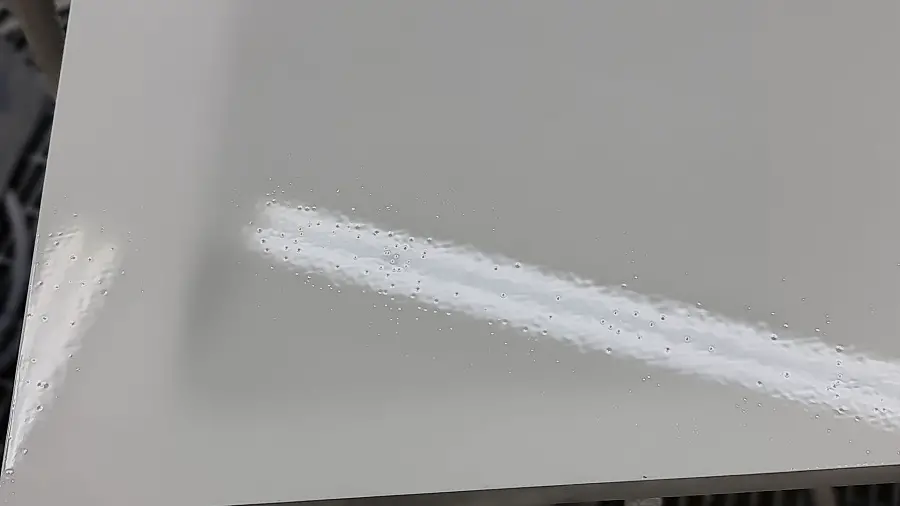A discussion on the finishing side with the owner of a bathroom furniture factory reminded me of the problems that arise in this part of production. Spray application spraying of varnishes or paints is often used and very often, especially in small and medium-sized factories, spraying is manual. Getting a great looking coat depends on several factors: the quality of the varnishes and paints, the quality of the spray gun/pump, the experience of the staff, the working environment, the maintenance of the routes, etc. Each of these factors can influence the quality of the coat and can make the difference between a good and a bad piece of furniture. But how do we figure out who is to blame when a defect occurs so we can see how to fix it? I'll talk more about this below.

How to identify the cause
Unfortunately, there is no magic method or device that can tell you instantly what the problem is and how to fix it. There are defects that are known and for which solutions are already identified - I'll come back to them in a moment - but very often we are faced with a film that doesn't look good at all and the first thought is that the lacquer/paint is to blame. But it's not always about the finishing materials.
As there are several factors involved in the process, they have to be eliminated one at a time to find out where the problem is coming from. And because the finishing material is the first one we think of, that's the one we eliminate. You don't have to change the supplier, just find a small amount of a different product and apply it in exactly the same conditions as the original. If the defect is repeated, it is not the finish material that is to blame and the problem should be looked for elsewhere.
Check the gun, the pressure, the routes, the working environment, everything that could affect the quality of the film, but change only one item each time. It's good to have a spare spray gun that can be used when needed. If you have a spray booth for application, change the location, do the application outside. You don't need to get perfect surfaces, just without the original defect.
When we have a problem, we tend to fix it without looking for the exact cause and so the problem reappears. I have frequently come across such approaches in factories. The easiest is to blame the lake. It may be true sometimes, but it has happened to me many times to identify problems that were not related to the finishing materials. Once resolved, the defects no longer appeared and the quality of the finish improved considerably.
Causes and solutions
We said above that there are also recognizable defects for which the remedy is known. They are both those related to finishing materials and those related to fittings, the improper use of certain installations, or failure to comply with certain requirements.
When the problem comes from the varnish or paint, it's not always the quality or choice that's to blame. For example, if the film looks gauzy, it's the thinner. The varnish may be of very good quality, but the thinner added may be unsuitable for the temperature in the room where it is being applied.
Sometimes the same defect can have several causes and they need to be removed one at a time to find out what started it all. Only by finding the exact cause will it not be repeated.
Below, some of the defects visible immediately after spraying and the cause of their appearance:
- orange peel - too thick coating, too little thinner added, too little distance between gun and panel,
- scum - too high dilution, wrong gun nozzle (too large), wrong application technique,
- gaseous film, air bubbles in the film - wrong thinner that evaporates too quickly (you need a heavier volatile one called a retarder), wrong gun setting (too much air), too much pressure, too high temperature at the spraying site,
- punctures in the film - water in the trails, if the applied lacquer is solvent based (compressor, air trails, air gun hose) or solvent in the enclosure, in the case of waterborne products,
- craters in the film - traces of oil, greasy substances left on the surface by hands, sanding or cloths used to wipe off dust from sanding between coats, silicone particles in the working environment,
- inclusions in the film - dust in the working area, cured varnishes with outdated pot-life, old materials.

Regarding punctures in the filmIt is better not to spray solvent-based and water-based materials in the same place and with the same gun. Sprayed particles are very fine and remain in the air for a long time. If you cannot use another space, leave at least 24 hours between solvent and water spraying. And if it is not possible to use different spray guns, rinse the spray gun with acetone or technical alcohol after regular washing. They are compatible with both water and solvents.
Dust in the working environment is the enemy of the finish, especially a high-gloss finish. Quality is greatly improved by using pressurised spray booths. But they won't be able to do their job if there is a source of dust inside. Never sand primer or wood inside the cabin, even for the smallest remedy. The resulting fine dust is picked up by the air currents inside and will end up on freshly finished surfaces.
Finish sells furniture, I always say it and I believe it. Next to the design, it is what you see and feel before you know what wood it is and how well it has been worked. Don't neglect it, and if there are problems try to find out the cause and then fix it.



































Add comment